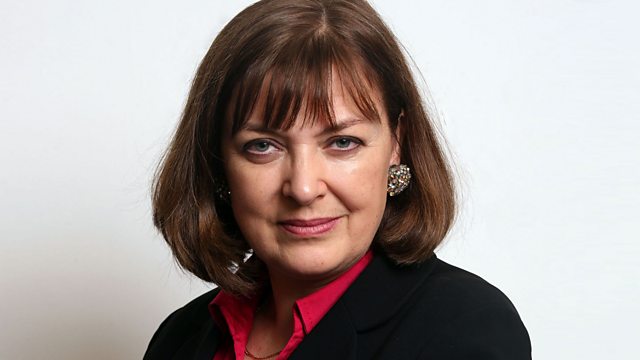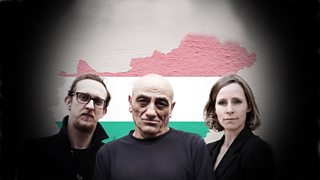
The Berlin Wall Crisis
By 1961, so many were fleeing communist East Germany that the country was in crisis. So the government built a wall to stop them. Bridget Kendall hears from three who escaped.
As part of her series tracing the crucial turning-points of the early Cold War, Bridget Kendall tells the story of the crisis that led up to the building of the Berlin Wall.
By 1961, so many were fleeing communist East Germany that the country was in crisis. So the government built the Berlin Wall to stop them. Would-be escapees were regularly gunned down.
Bridget hears the stories of three people who successfully fled East Berlin - one before the Wall went up, two who pulled it off even with the Wall in place.
And she finds out why they wanted to leave East Germany in the first place.
With: Leslie Colitt, Gisela Nicolaisen, Joachim Rudolph
Producers: Phil Tinline and Sabine Schereck.
Last on
More episodes
Previous
The Remains of the Wall in Berlin
Sabine Schereck grew up in Berlin and co-produced the Berlin episodes of the Cold War series. Here she reveals how the events covered in the series are still etched into her native city.
The Berlin Wall left its mark all over the city. For example, take the Mauerpark - the Wall Park, created on a section of the former no-man's land or border strip between East and West. (This is similar to what happened at Tempelhof Airport, where the large empty field is now a park, too.) Tourists might be familiar with the East Side Gallery, a more than 1km-long section of the wall with paintings by a range of artists.
After the fall of the Wall in 1989 the aim was to remove the Wall reunite the country and the city quickly. There was, however, an initiative to keep a section of the Wall with the border strip and a watchtower as a reminder.
So, in 1998, the Berliner Mauer Gedenkstätte opened on Bernauer Straße, where the Wall had divided the city. This Memorial bears the inscription: ‘In memory of the city's division from 13th August 1961 to 9 November 1989 and of the victims of communist tyranny’. Across the street from the memorial there’s a visitors’ centre and a documentation centre where you can find out more about the division of Germany and the Cold War.
The term ‘Cold War’ was not present during my school days in 1980s West Berlin.
I remember vividly though a drawing we made in the 3rd form that showed the divided Berlin and the three transit routes. We learned that the Wall was built in 1961 to prevent East Germans fleeing their country.
West Berlin was described as an “island in the red sea” and if you wanted to leave the city to get to West Germany by car, by bus or by train, a transit visa was necessary to travel through the GDR. Leaving West Berlin by plane did not require a visa.
The summer holidays were usually marked by sitting in a hot car, stuck in a long queue with thousands of other cars at Dreilinden, the crossing point between West Berlin and the GDR to get onto one of the transit routes. Among the Allies, this crossing point was known as Checkpoint Bravo, or Checkpoint B.
Checkpoint Alpha, was the one at Helmstedt-Marienborn at the inner German border, where, coming from the West, you would enter the GDR to get into West Berlin.
Checkpoint C, better known as Checkpoint Charlie, was the crossing point between East and West Berlin for foreigners and members of the Allied Forces. Berliners were not allowed to cross there.
In this edition of Cold War: Stories from the Big Freeze, Gisela Nicolaisen talks about people disappearing around her. They had fled to the West. The empty flats in the houses were then often given to party members who kept a close eye on the other tenants. This made life even more uncomfortable in the few private spaces that were left. She has captured her life in the GDR and her escape in the book Dann geh jetzt! (Then Go Now!).
In it she also points out how important it was to pretend that she had left the country because she had fallen in love with a West German pen pal. The authorities would always question friends and family as to why someone might have fled. Giving a romance as a reason spared her parents from major repercussions as they could not be accused of not having raised their daughter with the correct political mind set.
Gisela Nicolaisen, Leslie Colitt's fiancée Ingrid and Joachim Rudolph all passed through the refugee transit camp, the Notaufnahmelager, in Marienfelde, a district in the south of the city. It was opened in 1953 and later extended to cope with the stream of refugees coming from East Germany. On 12th August 1961 2,400 refugees were registered.
The experiences of refugees in the camp in the 1970s are brought to life in Julia Franck's book West. In 1993 parts of the camp were turned into a museum documenting this aspect of German history.
But not everybody saw their future in the West. In 1951, when there was still a ‘choice’, Heinz Odermann at the age of 22 moved from West Berlin to East Berlin.
As a 15-year-old he has been conscripted into the Second World War to fight under Hitler. He was one of three survivors from his company that consisted of 140 boys between the age of 14 and 17. Seeing former Nazis returning to prominent positions in West Germany, made him want to contribute to the building of a new society - the GDR, a new state that had written on its banners the eradication of former Nazis and the creation of a ‘fairer' society.
Odermann regarded the building of the Wall as an economic necessity as the flood of refugees was detrimental to the fledging state. However, the hope was that after five years, when the economy in the GDR had been stabilised, the Wall would come down again.
When the first lines of barbed wire closed the border overnight, it wasn’t just Germans who had to adapt.
The German-born Hollywood director Billy Wilder was shooting his Cold War comedy One, Two, Three at the time in Berlin. But after 13th August, the crew could no longer access East Berlin. They had to build a copy of the Brandenburg Gate on a backlot in Munich in order to finish shooting the film. The film did not go down well at the time; only in later years would the comedy be appreciated.
In hindsight there is also comedic value in this statement by the GDR's Head of State Walter Ulbricht: "Niemand hat die Absicht eine Mauer zu errichten." ("No one has the intention of building a wall.") He made this bold claim at a press conference on 15th June 1961, less than two months before the Wall became reality.
I wonder what he would have made of it if someone had told him at the time that in less than 30 years, his 'anti-fascist protection rampart', as the wall was called in the GDR, would be sold in small multi-coloured lumps in every souvenir shop in a united 'capitalistic' Berlin.
One of those souvenir shops is part of the Museum at Checkpoint Charlie, officially called the Mauer Museum. It opened in 1962 in a very improvised way both to trace the development of the Wall and also to show the unbelievable measures East Germans took to flee to the West.
A few underground stops away from Checkpoint Charlie, at Friedrichstraße station, is the Tränenpalast, the Palace of Tears. This is the colloquial name for the glass hall that was a border crossing point, where many a tear was shed when loved ones had to part. Germans and all other nationalities could cross there.
After the demise of the GDR, the hall lost its purpose. Entrepreneurs turned the empty space into a club with cabaret evenings. Although declared a listed building in 1990, the immediate past was not something Berliners wanted to be reminded of. The club closed in 2006 and lay idle. In 2011 it was turned into a museum showing what it was like to pass through the border controls, where suitcases were thoroughly checked and many questions were asked.
The ‘biography’ of this building is typical for many in Berlin - a defunct place is taken over by the creative industries and, when the project has exhausted itself, nothing happens for a while and until the authorities face the past and recognise the significance of the building for the history of the city.
In recent years many historic places in Berlin have been turned into museums or memorials. I think it is important that the memory is kept alive and the city’s history is preserved but there is nevertheless the concern that Berlin itself might become a museum, or worse, a Cold War theme park.
Broadcast
- Thu 21 Jul 2016 13:4591�ȱ� Radio 4
Foreign Bodies: Keeping the Wolf Out
Podcast
-
![]()
Cold War: Stories from the Big Freeze
Bridget Kendall presents an oral history tracing decisive moments of the Cold War.



